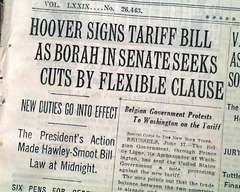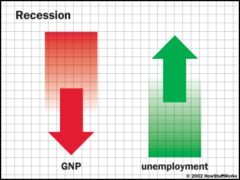AMSCO United States History 2015 Edition, Chapter 24 The Great Depression and the New Deal, 1929-1939
| 9037905633 | stock market crash | A boom stock market of 1928 led to a sell off starting in October 1929. Within three years the stock market would decline to one-ninth of its peak. This event is typically what marks the beginning of the Great Depression, although it was not the main cause. (p. 497) |  | 0 |
| 9037905634 | Black Tuesday | On October 29, 1929, millions of panicky investors sold their stocks, as the bottom fell out of the stock market. (p. 497) |  | 1 |
| 9037905635 | buying on the margin | This purchase method allowed people to borrow most of the cost of the stock, making down payments as low as 10 percent. Investors depended on the price of the stock increasing so they could repay their loans. (p. 497) |  | 2 |
| 9037905636 | uneven income distribution | Wages had risen relatively little compared to the large increases in productivity and corporate profits. Economic success was not shared by all, as the top 5 percent of the richest Americans received over 33 percent of all income. (p. 497) |  | 3 |
| 9037905637 | excessive debt | Consumers and businesses believed the economic boom was permanent so they increased borrowing, which later led to loan defaults and bank failures. (p. 498) |  | 4 |
| 9037905638 | overproduction | Business growth, aided by increased productivity and use of credit, led businesses to continue to produce goods that had no buyers. Workers with stagnant wages could not continue to purchase these goods, leading to decreased prices which led to decreased profits for businesses. (p. 498) |  | 5 |
| 9037905639 | Federal Reserve | During the Great Depression, this group followed a tight money policy. Instead of trying to stabilize banks, the money supply and prices, they tried to preserve the gold standard. (p. 498) |  | 6 |
| 9037905640 | debts and high tariffs | Leading up to the Great Depression, the United States insisted on full World War I loan repayments and high tariffs on imports. This weakened Europe and contributed to the worldwide depression. (p. 498) |  | 7 |
| 9037905641 | Gross Domestic Product | The value of all the goods and services produced by a nation in one year. In 1929, the United States GDP was $104 billion, but it dropped to $56 billion in 1932. (p. 498) |  | 8 |
| 9037905642 | unemployment | By 1933 25% of the workforce, not including farmers, did not have employment. (p. 498) |  | 9 |
| 9037905643 | bank failure | When banks were forced to close due to bank panics, in which people who had deposited their money pulled out all their funds. During the Great Depression 20 percent of all banks failed. (p. 498) |  | 10 |
| 9037905644 | Herbert Hoover | He was President of the United States at the time of the stock market crash. He thought that prosperity would soon return. He was slow to call for legislative action and he thought public relief should come from the state and local governments, not the federal government. (p. 500) |  | 11 |
| 9037905646 | Hawley-Smoot Tariff | In June 1930, President Hoover signed into law the highest tariff rates on European imports in history, ranging from 31 to 49 percent. In retaliation, European countries enacted their own tariffs on American goods. This reduced trade for all nations and worsened the worldwide depression. (p. 500) |  | 12 |
| 9037905648 | Farm Board | It was authorized to help farmers stabilize prices by temporarily holding surplus grain and cotton in storage. (p. 500) |  | 13 |
| 9037905649 | Reconstruction Finance Corporation | In 1932, Congress funded this government-owned corporation as a measure for propping up faltering railroads, banks, life insurance companies, and other financial institutions. President Hoover thought that emergency loans would stabilize key business and the benefits would "trickle down" to smaller businesses and ultimately bring recovery. (p. 501) |  | 14 |
| 9037905650 | Twentieth Amendment | Also known as the lame-duck amendment, this amendment shortened the period between the presidential election and inauguration. The new president's term would start on January 20. (p. 502) |  | 15 |
| 9037905651 | bonus march | Thousands of unemployed World War I veterans marched to Washington, D.C. and set up encampments to demand immediately payment of the bonuses promised to them at a later date. The Army, led by General Douglas MacArthur broke up the encampment. (p. 501) |  | 16 |
| 9037905652 | Franklin D. Roosevelt | This Democratic candidate won the 1932 presidential election. As a candidate, he promised a "new deal" for the American people, the repeal of Prohibition, aid for the unemployed, and cuts in government spending. (p. 502) |  | 17 |
| 9037905653 | Eleanor Roosevelt | She was the most active first lady in history, writing a newspaper column, giving speeches, and traveling the country. She served as the president's social conscience and influenced him to support minorities. (p. 502) |  | 18 |
| 9037905654 | New Deal | Franklin D. Roosevelt's plan to help people at the bottom of the economic pyramid. (p. 503) |  | 19 |
| 9037905655 | relief, recovery, reform | The New Deal included the three R's: immediate help people out of work, longer term assistance for business and the economy, and changes of American economic institutions to prevent another Depression from happening. (p. 503) |  | 20 |
| 9037905656 | Frances Perkins | Roosevelt's secretary of labor, she was the first woman to serve in a president's cabinet. (p. 503) |  | 21 |
| 9037905657 | Hundred Days | On March 4, 1933, Franklin Roosevelt started his term and called Congress into a one hundred day session. They passed into law all of Roosevelt's legislation. (p. 503) |  | 22 |
| 9037905659 | fireside chats | President Franklin Roosevelt would hold these casual-format talks on the radio addressing the America public and explaining new government policies. Intended to increase public confidence in the economy and government. (p. 504) |  | 23 |
| 9037905660 | Federal Deposit Insurance Corporation | This agency guaranteed individual bank deposits up to a certain amount. Intended to increase public confidence in banks and making deposits in banks again. (p. 504) |  | 24 |
| 9037905661 | Public Works Administration | Directed by Secretary of the Interior Harold Ickes, it allotted money to state and local governments for building roads, bridges, dams, and other public works. (p. 504) |  | 25 |
| 9037905662 | Civilian Conservation Corp | This organization employed young men for projects on federal lands and paid their families small monthly sums. Red Rocks Amphitheater was built thanks to the CCC in the 1930s. (p. 504) |  | 26 |
| 9037905663 | Tennessee Valley Authority | A government corporation that hired thousands of people in the Tennessee Valley, to build dams, operate electric power plants, control flooding, and erosion, and manufacture fertilizer. (p. 505) |  | 27 |
| 9037905664 | National Recovery Administration | Directed by Hugh Johnson, this agency attempted to guarantee reasonable profits for business and fair wages and hours for labor. The complex program operated with limited success for two years before the Supreme Court declared it unconstitutional. (p. 505) |  | 28 |
| 9037905666 | Securities and Exchange Commission | This agency was created to regulate the stock market and to place strict limits on the kind of speculative practices that led to the 1929 stock crash. (p. 505) |  | 29 |
| 9037905667 | Federal Housing Administration | It insured bank loans for building new houses and repairing old ones. (p. 505) |  | 30 |
| 9037905668 | Works Progress Administration | This agency created in 1935, part of the Second New Deal, it was much more ambitious than earlier efforts. Between 1935 and 1940 up to 3.4 million people were hired to construct bridges, roads, airports, and public buildings. Artists, writers, actors, and photographers were also employed. (p. 506) |  | 31 |
| 9037905669 | Wagner Act | A 1935 act that guaranteed a worker's right to join a union and a union's right to bargain collectively. It outlawed business practices that were unfair to labor. (p. 507) |  | 32 |
| 9037905670 | Social Security Act | In 1935, this act created a federal insurance program based on the automatic collection of taxes from employees and employers throughout people's working careers. This act was created to assist the poor, unemployed, children, and handicapped. (p. 507) |  | 33 |
| 9037905672 | recession of 1937 | In the winter of 1937 the economy went into recession again. The new Social Security tax had reduced consumer spending and at the same time Roosevelt had cut back government spending in hopes of balancing the budget. (p. 511) |  | 34 |
| 9037905673 | Father Charles Coughlin | A Catholic priest who founded the National Union for Social Justice, which called for issuing inflated currency and nationalizing all banks. His radio program attacks on the New Deal were anti-Semitic and Fascist. (p. 508) |  | 35 |
| 9037905675 | Huey Long | He proposed a "Share Our Wealth" program that promised a minimum annual income of $5000 for every American family to be paid for by taxing the wealthy. In 1935 he challenged Roosevelt's leadership of the Democratic party by becoming a candidate for president but was soon assassinated. (p. 509) |  | 36 |
| 9037905676 | Supreme Court | In the 1930s, this organization was controlled by Republicans who opposed the New Deal. In 1935, they declared two of President Roosevelt's recovery programs unconstitutional. (p. 509) |  | 37 |
| 9037905677 | court packing plan | President Franklin Roosevelt proposed a plan that allowed the president to appoint a new Supreme Court justice for each current justice over the age of 70. Congress refused to pass this legislation. This "court packing plan" would have allowed Roosevelt to appoint new Democratic justices. (p. 509) |  | 38 |
| 9037905681 | Fair Labor Standards Act | In 1938 this act established a minimum wage, a maximum standard workweek with extra pay for overtime, and child labor restrictions. (p. 511) |  | 39 |
| 9037905682 | minimum wage | Establish minimum pay for workers, initially set at 40 cents per hour. (p. 511) |  | 40 |
| 9037905683 | Dust Bowl | A severe drought in the early 1930s and poor farming practices led to this environmental disaster. High winds away large amounts of topsoil. Took place in the Great Plains areas including Oklahoma, Kansas, Nebraska, parts of Colorado and Texas. (p. 512) |  | 41 |
| 9037905684 | Okies | Derogatory term used to describe the poor farmers who left their farms in the great plains and moved westward into California. | 42 | |
| 9037905685 | John Steinbeck | A novelist that wrote about hardships in his classic study of economic heartbreak in 1939, "The Grapes of Wrath". (p. 512) |  | 43 |
| 9037905689 | Bracero Program | Made in agreement with Mexico in 1942, this program encouraged Mexican workers to move to the United States in exchange for a living wage, good working conditions, and a guarantee of non-discrimination. Led to a dependency on Mexican workers in the west and ultimately an increase in undocumented workers due to the demand from businesses to hire Mexican workers. |  | 44 |

